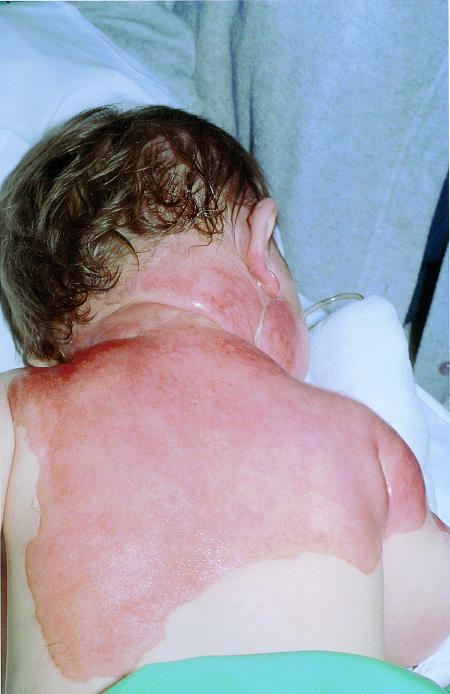Between February 1995 and April 1998, 23 young children were admitted to our burns unit because of scalds sustained after knocking or pulling over jugs or bowls of hot water which were being used to heat bottles of milk. We describe two of these cases in more detail to highlight the potential dangers of heating milk in this way.
Patients
The 23 children were aged between 2 weeks and 3 years (mean 14 months). Ten were boys and 13 were girls. Between 2% and 16% (mean 6%) of body surface area was affected by burns. Up to 33 nights (mean 5 nights) were spent in hospital. Most burns were superficial and healed without physical scarring, but 10 children were left with permanent scarring and two of these required skin grafting. Three children had scalds that affected more than 10% of their body surface area and needed formal resuscitation.
Case 1
A mother was warming a bottle of formula milk for her 9 month old daughter. She placed the bottle in a jug, filled this with freshly boiled water, and placed it on a low table for ease of access. The baby pulled the jug over, and in doing so scalded her lower face, neck, shoulder, and back so that 16% of her body surface area was affected (figure). She was transferred to the burns unit, where resuscitation was continued; regular dressing changes were needed. Areas of the shoulder and arm that would not heal were split skin grafted. The girl spent 33 nights in hospital, and numerous outpatient appointments have been necessary since. Eighteen months after the burn, she was still wearing pressure garments.
Case 2
A mother was warming a bottle of milk for her 3 month old child. She placed the bottle in a bowl and filled this with freshly boiled water. She then placed the bowl on the bed where she was lying with the infant. The bowl toppled over, causing 7% scalds to the baby's neck, shoulder, and upper arm. These all healed with dressings.
Discussion
Our 23 patients are probably the tip of the iceberg: only a few children with scalds are referred to the regional specialist burns unit, and fewer still are admitted. A previous audit of our data on paediatric patients admitted with burns showed that water being used to heat milk was the cause in 18% of cases with over 5% of the body surface area affected. This practice is therefore a major cause of scalding in young children.
We can find no record of this specific hazard in the published reports. The perceived need to warm milk for young children seems to vary from culture to culture. It has been reported that the temperature of milk feeds has no effect on gastric emptying,1 and many paediatric and special care baby units in this country do not routinely warm milk. In cultures where milk is usually warmed, new parents are often advised not to do this in a microwave oven. Midwives, health visitors, and paediatricians fear that uneven heating or overheating of the milk in the microwave oven may cause scalds to the mouth or throat.2–6 Instructions on tins of formula infant milk state that microwave ovens should not be used to heat the milk.
A study by Powell and Tanz in 1993 noted that microwave ovens pose a considerably smaller overall burn hazard to children than do conventional ovens.7 Their study used data obtained from the US Consumer Product Safety Commission and found that burns were about eight times more common with conventional cookers than with microwave ovens. It is also possible that scalding is more likely to occur when jugs or bowls of hot water are used to heat milk bottles than when this is done using microwave ovens. The risk of burn injury is certainly much higher in kitchens than in other rooms in the home, and it is particularly high within the “functional triangle” of space outlined by the line connecting the cooker, sink, and refrigerator (A Rossignol, personal communication).
Health professionals who deal with parents of young children should be aware of this hazard. The danger associated with warming milk bottles in jugs or bowls of boiling water could also be listed as a disadvantage of bottle feeding that could be avoided by breast feeding.
Figure.
Scalding caused by boiling water used to heat a bottle of formula milk
Using a bowl of boiling water to heat a baby's bottle increases the risk of scalds in young children
Footnotes
Competing interests: None declared.
References
- 1.Costalos C, Ross I, Campbell AGM, Sofi M. Is it necessary to warm infants' feeds? Arch Dis Childhood. 1979;54:899–901. doi: 10.1136/adc.54.11.899. [DOI] [PMC free article] [PubMed] [Google Scholar]
- 2.Hibbard RA, Blevins R. Palatal burn due to bottle warming in a microwave oven. Pediatrics. 1987;82:382–384. [PubMed] [Google Scholar]
- 3.Sando WC, Gallaher KJ, Rodgers BM. Risk factors for microwave scald injuries in infants. J Pediatr. 1984;105:864–867. doi: 10.1016/s0022-3476(84)80067-0. [DOI] [PubMed] [Google Scholar]
- 4.Garland JS, Rice TS, Kelly KJ. Airway burns in an infant following aspiration of microwave heated tea. Chest. 1986;90:621–622. doi: 10.1378/chest.90.4.621. [DOI] [PubMed] [Google Scholar]
- 5.Siu V, Kissoon N. Hazards of microwave ovens. Paediatr Emerg Care. 1987;3:99–103. doi: 10.1097/00006565-198706000-00010. [DOI] [PubMed] [Google Scholar]
- 6.Dixon JJ, Burd DAR, Roberts DGV. Severe burns resulting from an exploding teat on a bottle of infant formula milk heated in a microwave oven. Burns. 1997;23:268–269. doi: 10.1016/s0305-4179(96)00127-1. [DOI] [PubMed] [Google Scholar]
- 7.Powell EC, Tanz RR. Comparison of childhood burns associated with use of microwave ovens and conventional stoves. Pediatrics. 1993;91:344–349. [PubMed] [Google Scholar]



